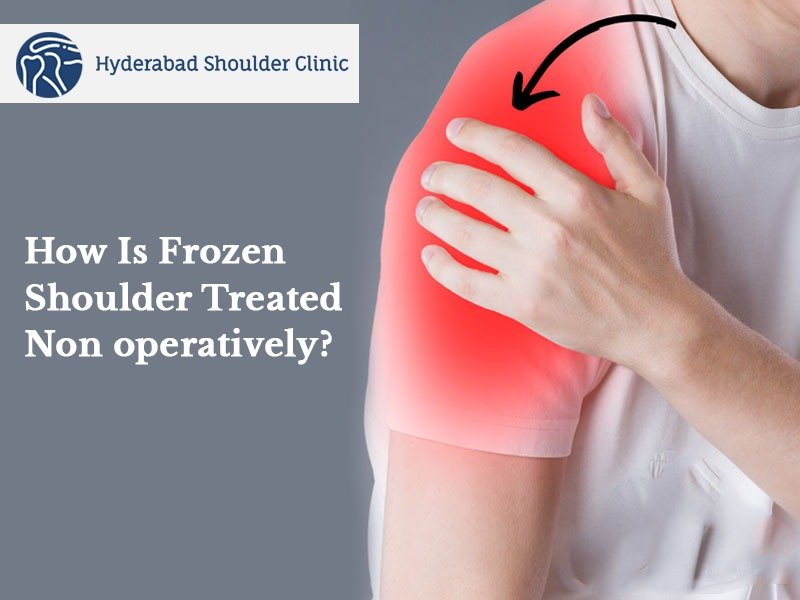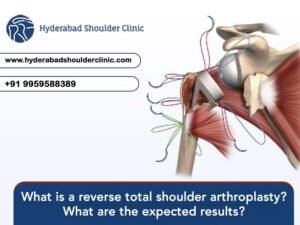The shoulder is made up of three bones and is a “ball in a socket” joint. The three bones that make up the shoulder are the upper arm bone, collarbone, and shoulder blade. The shoulder blade fits into the upper bone of the shoulder and visually creates a “ball and socket.” The synovial fluid in the shoulder helps keep the joints lubricated for a more comfortable range of motion, while healthy connective tissue surrounds the joints.
Frozen shoulder, also known as adhesive capsulitis, is a common condition that develops over time and limits the range of motion of your shoulder joint. This condition occurs when the tissue that surrounds the shoulder joint, known as the capsule, becomes thicker and narrower as it shrinks and forms scar tissue. This condition most commonly affects women between the ages of 40 and 60.
Frozen shoulder often occurs for no apparent reason. Some patients experience frozen shoulders after a traumatic shoulder injury, but this is not a common cause. People with diabetes have a higher risk of developing this disease.
Dr Chandra Sekhar.B provides information about the frozen shoulder and its nonsurgical treatment.
What is a frozen shoulder (adhesive capsulitis)?

Adhesive capsulitis is stiffness in the shoulder due to scarring that causes painful movement and loss of motion. The exact cause of adhesive capsulitis is debatable. Some believe it is caused by inflammation, such as when the joint’s lining becomes inflamed (synovitis) or by an autoimmune reaction in which the body begins to “attack” its substances and tissues. Other possible reasons are:
- Reaction after injury or surgery
- Pain from other conditions such as arthritis, rupture of the rotator cuff, bursitis, or tendonitis that causes a person to stop moving their shoulders
- Immobilization of the arm, for example, in a sling, after surgery or a fracture.
However, there is often no apparent reason why adhesive capsulitis develops.
How does it feel and stages of frozen shoulders?

Most people with adhesive capsulitis experience worsening pain and loss of movement. The adhesive capsule can be disassembled in 4 stages; Your doctor can help you determine what stage you are at.
Stage 1: Pre-freezing: In phase 1 of your development, it may be challenging to identify your problem as adhesive capsulitis. You have symptoms for 1 to 3 months, and they get worse. Movement of the shoulder causes pain. It usually hurts when not in use, but the pain increases and becomes sharp with movement. During this time, you will begin to limit the shoulders’ movement and protect them by reducing their use. Loss of motion is most noticeable in external rotation (i.e., when you turn your arm away from your body), but you can start to lose movement if you raise your arm or reach back. Pain is a characteristic feature of this phase; You can be in pain during the day and at night.
Stage 2: Freeze: At this point, you have symptoms for 3 to 9 months, most likely with progressive loss of shoulder motion and increased pain (especially at night). The shoulder still has some range of motion but is limited by pain and stiffness.
Stage 3: Frozen: Your symptoms last for 9 to 14 months, and you have minimal Mobility. At this early stage, there is still significant pain. However, towards the end of this stage, the pain subsides, and the pain usually only occurs when you move your shoulder as far as possible.
Stage4: Thawing: You have symptoms for 12 to 15 months, and there is a sharp decrease in pain, especially at night. You still have limited freedom of movement, but your ability to complete daily activities with overhead traffic is increasing rapidly.
Symptoms:
Most patients with frozen shoulders experience dull pain when they first move the shoulder. As pain increases, people tend to limit the use of the shoulder, which increases stiffness, and all range of motion is lost. Sleeping on the same side as the affected shoulder and doing normal daily activities such as washing hair and dressing, can be very painful.
How to diagnose it?

Doctors often see patients with adhesive capsulitis only when they are in the freezing stage or early frozen stage. Sometimes people are treated for other shoulder conditions when their doctor notices signs and symptoms of adhesive capsulitis. Your doctor will perform an in-depth examination, including a detailed medical history, to rule out other diagnoses. Your doctor will look for a specific pattern in your reduced range of motion called a capsular model of adhesive capsulitis. Additionally, your doctor will consider other conditions you may have, such as diabetes, thyroid disease, and autoimmune diseases associated with adhesive capsulitis.
How Is Frozen Shoulder Treated Nonoperatively?

The goal is to relieve pain and maintain mobility and flexibility of the shoulder. Over time and during treatment, 9 out of 10 people experience relief. However, recovery can be slow, and symptoms can last for several years. There are several ways to relieve pain and relieve the condition.
- Pain relief medications: Nonsteroidal anti-inflammatory drugs Over-the-counter pain relievers such as aspirin and ibuprofen (Advil, Motrin IB, etc.) can help relieve pain and inflammation associated with frozen shoulders. In some cases, your doctor may prescribe more potent pain relievers and anti-inflammatory drugs.
- Hot or cold compression: May relieve pain and swelling. Switching between the two can help. They can be purchased online.
- Corticosteroid injections: Steroid Injections Injecting corticosteroids into the shoulder joint can help relieve pain and improve shoulder mobility, especially in the early stages of the process. However, repeated corticosteroid injections are not recommended because they can cause side effects, including further shoulder injury.
- Transcutaneous Electrical Nerve Stimulation (TENS): This works by tingling the nerve endings in the spinal cord that control pain. The TENS machine sends out tiny electrodes, or small electrical pads placed on the skin of the affected shoulder. Various brands of TENS machines can be purchased online.
- Physiotherapy: This can provide training in exercises to maintain maximum Mobility and flexibility without putting pressure on the shoulder or causing excessive pain
A physiotherapist can teach you movement exercises to restore as much Mobility to the shoulder as possible. Your commitment to this exercise is essential to optimize your mobility recovery. Careful physical therapy is often necessary for recovery. The physical therapist will prescribe ultrasound, electrical stimulation, manoeuvres with stretches, ice packs, and possibly strengthening exercises. Recovery from physical therapy can take weeks to months, depending on the scar tissue’s severity around the shoulder.
People with frozen shoulders need to avoid reinjuring the shoulder tissue during the rehabilitation period. These people should avoid sudden shaky movements or lifting heavy weights with the affected shoulder.
Surgical Treatment:

Sometimes the frozen shoulder is resistant to treatment. Patients with a resistant frozen shoulder may consider exposing the scar tissue through arthroscopic surgery or manipulating the shoulder characterized by anaesthesia. This manipulation is performed to destroy scar tissue in the joint capsule physically. After any surgery, Mobility and function are only optimized with longer shoulder workouts. Most frozen shoulders will heal on their own within 12 to 18 months. If symptoms persist, your doctor may suggest the following:
- Joint distension: Injecting sterile water into the joint capsule can help stretch the tissue and make the joint more comfortable to move.
- Shoulder manipulation: The shoulder joint moves slightly while the patient is under general anaesthesia .so that you will pass out and feel no pain. The doctor then moves your shoulder joint in different directions to loosen tight tissue.
- Shoulder Arthroscopy: Frozen shoulder surgery is rare, but if nothing works, your doctor may recommend surgery to remove scars and adhesions on the inside of the shoulder joint. Minimally invasive surgery is used in a minority of cases. An endoscope or a small tube is inserted through a small incision in the shoulder joint to remove scar tissue or adhesions.
Conclusion:
One of the most common causes of frozen shoulder is immobility, which can occur during recovery from a shoulder injury, broken arm, or trauma. If you’ve had an injury that makes it difficult to move your shoulder, talk to a doctor about exercises and treatment you can do to help maintain your shoulder joint movement.
For more information about the frozen shoulder and the best treatment options, contact Dr Chandra Sekhar.B at 9959588389.





